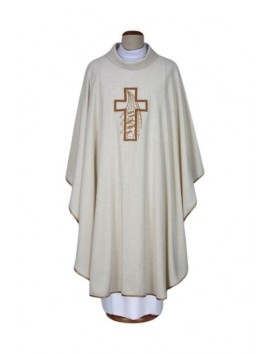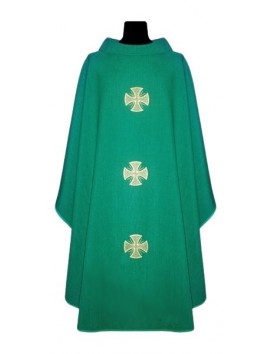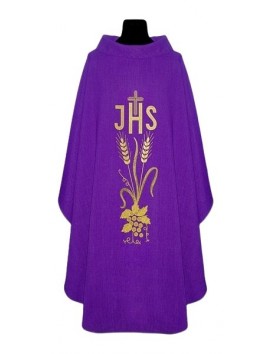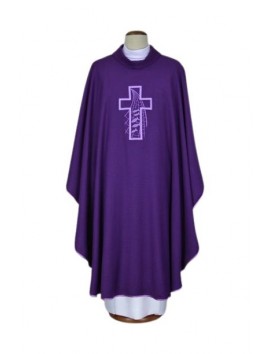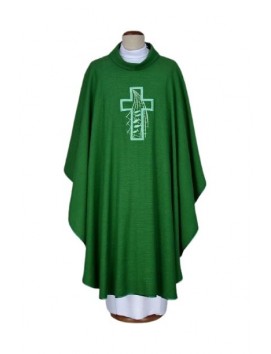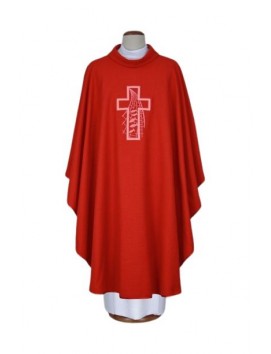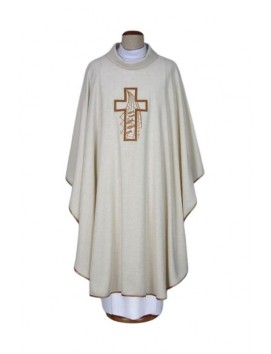No products
Linen chasubles
Linen chasubles are a type of liturgical vestment made of linen fabric. They are often used as a replacement for heavier vestments during the summer months because linen is lightweight and absorbs moisture. Linen chasubles can be embroidered with various designs and symbols, such as crosses or images of saints. They are available in different styles, including Gothic, Roman, Semi-Gothic, and Monastic. Linen chasubles are often handmade and can be purchased from various online shops. They are designed to keep the priest feeling comfortable during the celebration of Mass, while also adhering to the liturgical colors and traditions of the Church.
Linen chasubles are a type of liturgical vestment made of linen fabric. They are often used as a replacement for heavier vestments during the summer months because linen is lightweight and absorbs moisture. Linen chasubles can be embroidered with various designs and symbols, such as crosses or images of saints. They are available in different styles, including Gothic, Roman, Semi-Gothic, and Monastic. Linen chasubles are often handmade and can be purchased from various online shops. They are designed to keep the priest feeling comfortable during the celebration of Mass, while also adhering to the liturgical colors and traditions of the Church.
Linen Chasubles: A Blend of Tradition and Comfort
Linen chasubles are not just a piece of clothing; they are a symbol of tradition, spirituality, and the dedication of those who wear them. These liturgical vestments, primarily worn by clergy during the celebration of the Eucharist, have a rich history that dates back centuries. But what makes linen chasubles stand out in the vast world of ecclesiastical attire? Let's dive into the world of these fascinating garments and discover their unique blend of tradition and comfort.
The Historical Tapestry of Linen Chasubles
Linen chasubles have roots that intertwine deeply with the history of Christian liturgical practices. Originating from the simple Roman garment, the 'casula' or 'little house,' they have evolved from being a practical cloak to a symbol of pastoral care and service. The transition from heavy, ornate fabrics to the use of linen marked a significant shift towards simplicity and functionality.
Why Linen?
Linen is celebrated for its durability, comfort, and elegance. It's a natural fiber known for its breathability and ability to absorb moisture without feeling damp. For clergy members who wear these garments for extended periods, often in warm sanctuaries or during outdoor services, linen chasubles offer unparalleled comfort. Moreover, linen's natural sheen adds an understated elegance to the vestment, enhancing the solemnity of the liturgical celebration.
The Evolution of Style
The design of chasubles has seen a transformation from the conical and bell-shaped forms of the early centuries to the more streamlined shapes of today. This evolution was not just a matter of fashion but also functionality, allowing for greater freedom of movement during services. The reintroduction of linen chasubles, especially in lighter, more breathable forms, reflects a return to the early church's values of simplicity and focus on the spiritual rather than the material.
Linen Chasubles in Modern Times
Today, linen chasubles are available in various styles, including Gothic, Roman, and Monastic, each with its symbolic significance and aesthetic appeal. They are often adorned with symbolic colors and embroidery that reflect the liturgical season or the specific celebration. The choice of linen as a material not only honors the tradition but also caters to the modern need for comfort and practicality.
Caring for Linen Chasubles
Maintaining linen chasubles requires a bit of care to preserve their beauty and longevity. Regular washing in mild detergent and lukewarm water can keep them looking their best. Ironing while damp can help maintain the fabric's natural sheen. Proper care ensures that these vestments can be worn for years, if not generations, becoming a cherished part of the church's heritage.
FAQs
Q: Can linen chasubles be worn all year round?
A: Yes, linen chasubles can be worn throughout the year. Their breathability makes them comfortable in warmer months, while their layering over other liturgical garments provides warmth in cooler seasons.
Q: Are linen chasubles suitable for all liturgical celebrations?
A: Linen chasubles, with appropriate colors and symbols, are suitable for most liturgical celebrations. However, specific traditions or celebrations might require different vestments.
Q: How can one distinguish between different styles of linen chasubles?
A: The style of a linen chasuble is often indicated by its cut, length, and the presence or absence of ornamentation such as embroidery or appliqués. Gothic chasubles tend to have a fuller cut, while Roman chasubles are more fitted.
Q: Can linen chasubles be customized?
A: Yes, many vestment makers offer customization options for linen chasubles, allowing for the incorporation of specific symbols, colors, or embroidery that reflects the wearer's ministry or the community's identity.
In Conclusion
Linen chasubles are more than just a vestment; they are a testament to the enduring legacy of the church's traditions, marrying the ancient with the modern in both form and function. Their comfort, elegance, and symbolic richness, including the chasuble, make them a cherished choice for clergy around the world. As we continue to celebrate our faith's rituals and ceremonies, linen chasubles stand as a reminder of our spiritual heritage and the timeless call to serve.

